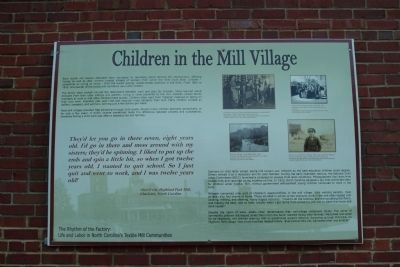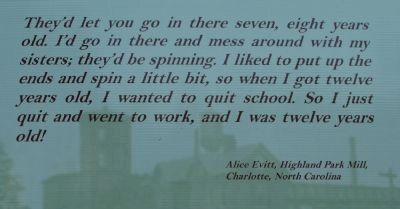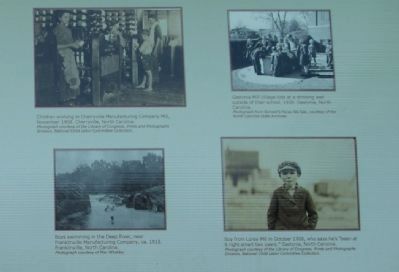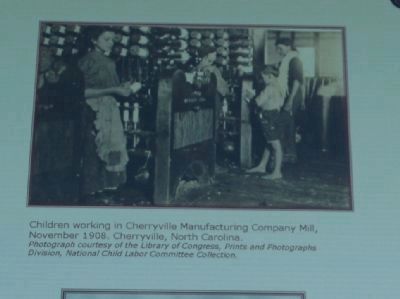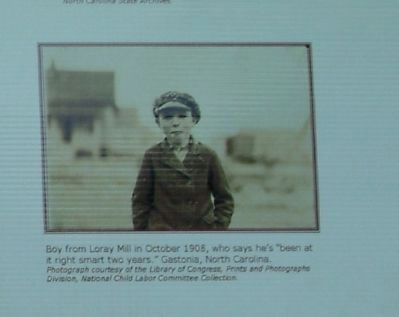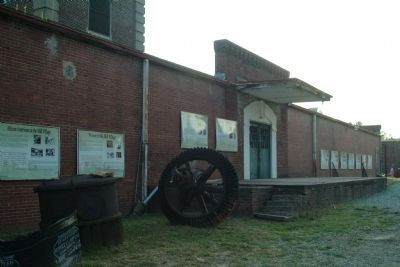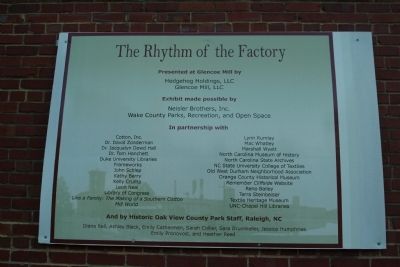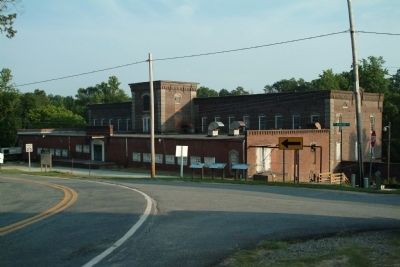Glencoe Village near Burlington in Alamance County, North Carolina — The American South (South Atlantic)
Children in the Mill Village
The family labor system blurred the distinctions between work and play for children. Many learned about millwork from their older siblings and parents. Living in close proximity to the mill, children visited family members at work or visited other children there to play. Children often went from "helping" relatives to taking on their own work. Available jobs paid little and required more dexterity than skill. Many children worked as doffers, sweepers, and spinners, earning just a few dollars per week.
Most mill villages provided free schooling through sixth grade, though many children attended sporadically, or for only a few years. A child's income sometimes made the difference between poverty and subsistence, therefore having a child work was often a necessity for mill families.
Opinions on child labor varied. Some mill owners saw millwork as the best education children could receive. Others viewed it as necessary for poor families. During the early twentieth century, the National Child Labor Committee (NCLC) launched a campaign to expose child labor conditions. Photographers like Lewis Hine visited mills and captured young workers on film. In 1913, North Carolina adopted a law that prohibited labor for children under twelve. Still, without government enforcement young children continued to work in the mills.
Millwork comprised only part of children's responsibilities in the mill village. With working parents, most children also had chores at home. Those enrolled in school or too young to work in the mill often helped with cooking, milking, and cleaning. Henry rogers recounts, "I had to do the cooking, and the scrubbing the floors, and making the beds, and so forth. Usually when I got home from school my job was to clean the house and cook supper."
Despite the rigors of work, adults often remembered their mill-village childhoods fondly. The sense of community children felt helped shield them from the harsh realities facing their families. Welcomed and cared for by neighbors, mill children grew up with an established support network. According to Hugh McCorkle, his Highland Park village "was a two-hundred headed family. Everyone on this hill, we looked after one another."
Topics. This historical marker is listed in these topic lists: Education • Industry & Commerce • Notable Places • Settlements & Settlers. A significant historical year for this entry is 1880.
Location. 36° 8.342′ N, 79° 25.677′ W. Marker is near Burlington, North Carolina, in Alamance County. It is in Glencoe Village. Marker is on Glencoe Street, on the left when traveling west. Glencoe Village is 3 miles north of Burlington, NC from NC Highway 62. Touch for map. Marker is at or near this postal address: 2406 Glencoe St, Burlington NC 27217, United States of America. Touch for directions.
Other nearby markers. At least 8 other markers are within walking distance of this marker. Living in a Mill-Centered World (here, next to this marker); Women in the Mill Village (here, next to this marker); Men in the Mill Village (here, next to this marker); Picker House and Dye House (here, next to this marker); Neighbors Divided (here, next to this marker); Calling the Mill Village 'Home' (here, next to this marker); The Rise of the Textile Mill Communities (here, next to this marker); The Mill Buildings (a few steps from this marker). Touch for a list and map of all markers in Burlington.
Related markers. Click here for a list of markers that are related to this marker. To better understand the relationship, study each marker in the order shown.
Additional keywords. Alamance Cotton Mill, Glencoe, Fabric, Textiles, Company Shops, Holt,
Credits. This page was last revised on May 11, 2023. It was originally submitted on July 5, 2010, by Patrick G. Jordan of Graham, North Carolina. This page has been viewed 977 times since then and 19 times this year. Last updated on May 9, 2023, by Michael Buckner of Durham, North Carolina. Photos: 1, 2, 3. submitted on July 5, 2010, by Patrick G. Jordan of Graham, North Carolina. 4, 5. submitted on July 9, 2010, by Patrick G. Jordan of Graham, North Carolina. 6, 7, 8. submitted on July 5, 2010, by Patrick G. Jordan of Graham, North Carolina. • J. Makali Bruton was the editor who published this page.
